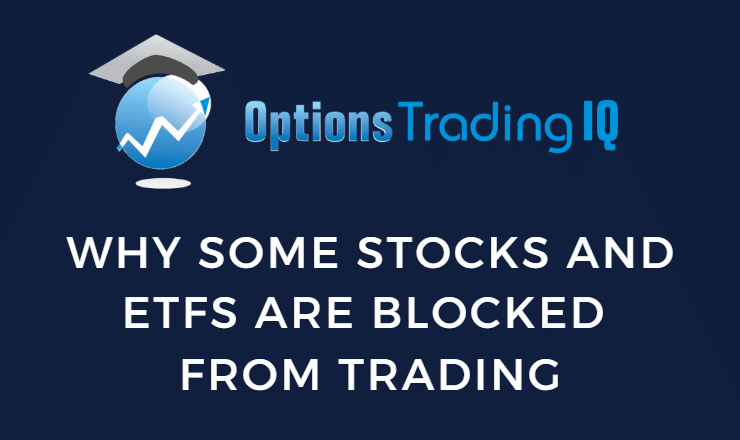
At certain times, certain brokers have blocked the trading and investment of certain stocks and ETFs of certain types of accounts based on government regulations or the particular bank’s risk policies.
Contents
The types of accounts in which these restrictions have been placed are usually more conservative retirement accounts (such as IRA accounts) with lower levels of trading privileges.
We will look at some of these stocks and ETFs.
They are by no means an inclusive list.
And these restrictions certainly do not apply to all accounts.
You will need to contact your bank to see whether they are blocked in your particular account.
During the 2021 meme stock craze driven by retail trading surges, the stocks AMC (AMC Entertainment) and GME (GameStop) experienced dramatic price swings.
This raised the concerns of regulators noting unusual trading activity and led some brokers to block such stocks (at least for a limited time).
TQQQ is a three-times leveraged ETF tracking the Nasdaq-100 index.
When the Nasdaq-100 goes up by 1%, the TQQQ is designed to go up by 3%.
The reverse is also true.
When the Nasdaq drops, the TQQQ drops three times as much (in percentage terms).
For example, the Nasdaq-100 ETF (QQQ) dropped from $535.80 to $516.47 in one day (from the close of December 17th to the close of December 18th, 2024) – a 3.6% drop.
During that same time, TQQQ dropped from $92.04 to $82.09, representing a 10.8% daily drop.
Some banks may block such leveraged ETFs, possibly citing that this kind of leverage is often not aligned with diversification and risk management principles recommended for retirement accounts.
SVXY is a “short volatility” ETF designed to deliver -0.5 times the daily performance of the S&P 500 VIX Short-Term Futures Index.
While the SVXY is based on the VIX Futures index (and not the VIX), for the purpose of this example, we are using the VIX as a proxy surrogate because the VIX has a strong correlation to the VIX Future Index (correlation of usually above 0.8).
It is easier and more commonly understandable to pull up the chart of the VIX.
The negative sign in “-0.5” is significant because it means that the SVXY will go up when VIX goes down.
Hence, SVXY is supposed to profit when VIX or volatility decreases.
In theory, volatility decreases more often than it goes up.
But occasionally, the VIX can spike up with a vengeance, causing a big loss in the SVXY.
After the FOMC meeting on December 18th, 2024, when the market dropped, the VIX spiked from 15.88 to 27.61.
SVXY went from $52.21 to $47.69, down 8.6% in a day.
This is the second-largest VIX spike since 1990.
It was only surpassed by the VIX spike of February 5th, 2018 (known as Volmageddon), which resulted in the termination of the XIV.
XIV is a -1.0 times inverse volatility exchange-traded note (ETN).
The SVXY is similar, except it is only half leveraged at -0.5x.
(And SVXY is an ETF as opposed to an ETN).
Why was XIV terminated?
It had to comply with its “acceleration clause” triggered by the catastrophic losses from the VIX spike.
Gasp!
This is why some banks say that Inverse volatility products like SVXY are highly complex and risky and are unsuitable for most retail investors who may not fully understand the risks outlined in the prospectus, including the possibility of termination.
Some banks also block UVXY, a “+2.0x” leverage product that provides amplified exposure to the daily performance of VIX futures.
When VIX goes up, UVXY goes up.
GBTC (Grayscale Bitcoin Trust) is an investment vehicle allowing investors to gain Bitcoin exposure.
We can only surmise the reasons why some banks might block bitcoin.
They may cite reasons such as cryptocurrency risks and the product’s specific nature with its regulatory gray area.
And finally, there are certain high-risk stocks, penny stocks, non-publicly traded, and OTC (over-the-counter) stocks that are blocked due to low price, thin liquidity, tracking errors, and/or high risk.
You will most likely not encounter such restrictions if you are in an active trading account.
But suppose you ever get a message saying that security is not permitted.
In that case, you know that it might be because it has the potential for volatile performance, higher expense ratios, lower liquidity, and/or higher risk of fund closure.
We hope you enjoyed this article on why some stocks and ETFs are blocked.
If you have any questions, please send an email or leave a comment below.
Trade safe!
Disclaimer: The information above is for educational purposes only and should not be treated as investment advice. The strategy presented would not be suitable for investors who are not familiar with exchange traded options. Any readers interested in this strategy should do their own research and seek advice from a licensed financial adviser.

